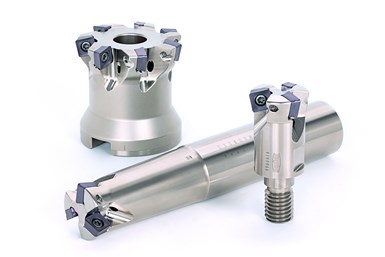Tungaloy MillQuadFeed Products Enhance High-Feed Milling
Tungaloy has expanded its MillQuadFeed high-feed milling cutter series by adding new grades and cutter body options for its SWMT09 insert range to enhance high-feed milling capability.
Share






Tungaloy has expanded its MillQuadFeed high-feed milling cutter series by adding new grades and cutter body options for its SWMT09 insert range.
MillQuadFeed offers two
options of insert geometries for various high-feed milling applications. Versatile ZER geometry generates light cutting loads at high depths of cut, enabling increased cutting depths and reduced number of machining passes. This is particularly useful in challenging rough-milling operations of cast iron, where cutting depth can vary greatly on a single working surface. UER geometry is designed to provide the cutter with small entry angle, producing thinner chips during machining and thereby lightening the cutting load impact on the inserts’ cutting edge. UER geometry is useful for high-feed machining of exotic materials where long insert life is crucial. Another feature of MillQuadFeed is its density of inserts per diameter — seven inserts in 50 mm (2") diameter — because of the small SWMT09 inserts.
New to the series is the HXSW09 modular-style cutter head, available in 25 mm and 32 mm diameters, which is suited for any high-feed milling operation.
The shell mill cutter line has new diameter additions, adding 52 mm and 63 mm diameters to its preexisting line of 40 mm and 50 mm diameter cutters.
In addition, the company has introduced a line of coarse-pitch design cutters to address needs for fewer teeth in contact with the work surface and minimizing chatter.
Related Content
-
Emuge-Franken Threading Tools Mill Challenging Materials
The company has expanded its offerings of solid-carbide thread mills with new products for challenging applications.
-
Emuge-Franken End Mill Wins ANCA's Tool of the Year Award
Emuge-Franken received the award for its specialized tool based on the new Cera-Cut end mill design.
-
How to Mitigate Chatter to Boost Machining Rates
There are usually better solutions to chatter than just reducing the feed rate. Through vibration analysis, the chatter problem can be solved, enabling much higher metal removal rates, better quality and longer tool life.















